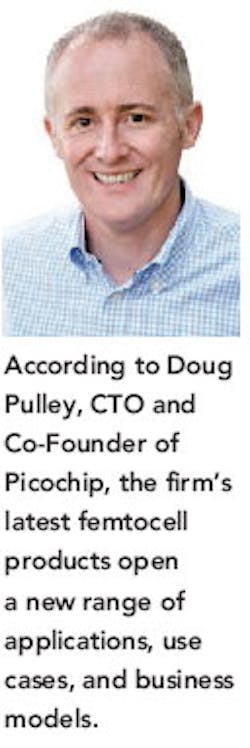Forum Awards Recognize Technical Progress As Femtocell Global Deployment Grows 60%
"We're delighted to have successfully demonstrated that our LTE solution is both capable and compatible," said Nigel Toon, Picochip CEO. "Our system-level approach to LTE base-station design gives our customers a low-risk route to market that our competitors simply cannot offer."
The PC960x is a base-station reference design in a TCA chassis. It integrates a radio, physical-layer (PHY) software, and Continuous Computing's protocol stacks running on a Cavium OCTEON processor into a complete system. The reference design supports all of the standard modes of LTE with both TD-LTE and FDD variants. In addition, it provides an evolutionary path to future versions of the standard including LTE-Advanced (LTE-A).
The Odyssey 9000 chipsets for LTE are the latest in a series of multi-protocol products from Cavium featuring CAT-3 performance (100 Mb/s downlink, 50 Mb/s uplink). They target UE productssuch as Universal Serial Bus (USB) dongles, data cards, mobile handsets, and tablets/ MIDsby delivering low power, flexibility, and price/performance. The Odyssey family also supports all of the LTE modes with 10-MHz, 20-MHz, TD-LTE, and FDD support. The programmable PHY architecture allows the Odyssey 9000 series to support existing LTE bands, as well as future bands that are ratified by the 3GPP.
The Trillium LTE wireless protocol software addresses LTE femtocells (Home eNodeB) and pico/macro eNodeBs, as well as the Evolved Packet Core (EPC) Mobility Management Entity (MME), Serving Gateway (SWG), Evolved Packet Data Gateway (ePDG), and more. These standards-based Trillium LTE wireless protocols let customers rapidly develop LTE infrastructure equipment so that they can compete for early design wins in the dynamic LTE marketplace.
FEMTO FORUM AWARDS
In addition to its succesful demo, Picochip picked up an award at the Femto Forum Awards, which took place during the Femto World Summit. The company won the Best Residential Technology Award for its next-generation femtocell product, the PC3008. This device lets manufacturers fit a third-generation (3G) base station into a small form factor, such as a USB stick.
Picochip believes that this size reduction along with an industry-standard USB interfacewill make femtocells a viable offering for a range of service providers. In addition to established cellular carriers, they could be leveraged by wireline operators and any provider with an installed base of home gateways, access equipment, or settop boxes (STBs) within homes. "By allowing our customers to put a 3G base station on a USBsized device, we've opened up a whole new range of applications, use cases, and business models," commented Doug Pulley, CTO and Co-Founder of Picochip (see photo).
In addition, NEC pocketed the award for "Social VisionPromoting Femtocells for Social, Economic, and Environmental Development." The award recognized the company's work in developing rural femtocell solutions worldwide to bring rural community femtocells closer to reality. NEC has 16 contracts worldwide and 30 trials with operators around the world.
Other winners at the 2011 Femto Forum Awards included Alcatel Lucent for its range of 3G metro cells as well as its work on applications and developer outreach. In addition, ip.access won for its OysterCatcher performance and fault-diagnosis system, while Vodafone received awards in two categories for progress in its commercial deployments.
About the Author
Paul Whytock
Editor-in-Chief
Paul Whytock is European Editor for Microwaves & RF and European Editor-in-Chief for Electronic Design. He reports on the latest news and technology developments in Europe for his US readers while providing his European engineering audience with global news coverage from the electronics sector. Trained originally as a design engineer with Ford Motor Co., Whytock holds an HNC in mechanical, electrical, and production engineering.
